Transcription & Call Review

Transcription and call review processes are integral parts of quality assurance and performance evaluation in customer support and sales operations. Let’s break down these processes into steps and delve into each one in detail:
Call Recording:
- Purpose: Call recording serves multiple purposes, including quality assurance, compliance monitoring, training, and dispute resolution. It allows organizations to capture and retain a record of customer interactions for various business needs.
- Methods: Calls can be recorded using specialized call center software, customer relationship management (CRM) systems, or dedicated recording devices. Some systems may offer automatic call recording, while others require manual initiation of recording by agents or supervisors.
- Compliance Considerations: Organizations must adhere to legal and regulatory requirements when recording calls, such as obtaining consent from callers, notifying them of the recording, and securely storing the recorded data to protect customer privacy.
Transcription:
- Manual vs. Automated: Transcription can be performed manually by human transcribers or automatically using speech recognition software. Manual transcription ensures accuracy and may capture nuances such as tone of voice and emotions, but it can be time-consuming and expensive. Automated transcription is faster and more cost-effective but may sacrifice accuracy, especially with accents or technical terminology.
- Accuracy and Quality Control: Regardless of the method used, ensuring the accuracy of transcriptions is crucial. Quality control measures, such as proofreading, editing, and reviewing transcriptions for errors, are essential to maintain data integrity and reliability.
- Data Storage: Transcribed calls are typically stored electronically in a secure database or document management system. Proper organization and indexing of transcriptions facilitate easy retrieval and analysis when needed.
Call Review:
- Evaluation Criteria: Call reviews are conducted based on predefined evaluation criteria or scorecards, which outline the key performance metrics and behaviors that are assessed during the review process. These criteria may include factors such as agent professionalism, accuracy of information provided, adherence to scripting or compliance guidelines, and resolution of customer issues.
- Feedback and Coaching: Call reviews provide an opportunity for quality assurance (QA) analysts or supervisors to provide feedback and coaching to representatives. Positive reinforcement of strengths and constructive feedback on areas for improvement help agents enhance their skills and performance.
- Quality Assurance Standards: QA analysts ensure that call review processes adhere to established quality assurance standards and guidelines. Consistency and fairness in evaluating calls across different agents and teams are essential to maintain the integrity and effectiveness of the review process.
Analysis and Reporting:
- Data Analysis: Following the completion of call reviews, QA analysts analyze the data collected during the review process to identify trends, paterns, and areas of concern. This analysis involves aggregating performance metrics, categorizing call outcomes, and identifying root causes of issues or challenges.
- Insights Generation: The analysis of call review data generates actionable insights that inform decision- making and drive continuous improvement in customer support/sales operations. These insights help identify training needs, process inefficiencies, compliance gaps, and opportunities for enhancement.
- Report Generation: Reports summarizing the findings of call reviews are generated and distributed to relevant stakeholders, including support/sales managers, team leaders, and individual representatives. These reports provide a comprehensive overview of performance trends, areas of excellence, and opportunities for improvement.
Continuous Improvement:
- Iterative Process: The transcription and call review processes are iterative, meaning that insights gained from previous reviews inform subsequent actions and improvements. Organizations continuously monitor and refine their quality assurance practices to adapt to changing business needs, customer expectations, and industry trends.
- Feedback Loop: Feedback from call reviews and performance evaluations is used to drive targeted interventions, such as additional training programs, coaching sessions, process refinements, or technology upgrades. This feedback loop ensures that corrective actions are implemented effectively to address identified areas for improvement.
- Commitment to Quality: Continuous improvement is driven by a commitment to delivering high-quality customer support and sales experiences. Organizations that prioritize quality assurance and invest in ongoing improvement initiatives are beter positioned to meet customer needs, drive satisfaction, and achieve business success.

Have Any Question?
Don’t hesitate to reach out to us; we’re here to assist you with any inquiries or support you may need.
- +1 727 498 0123
- info@benchmarkbpo.com

